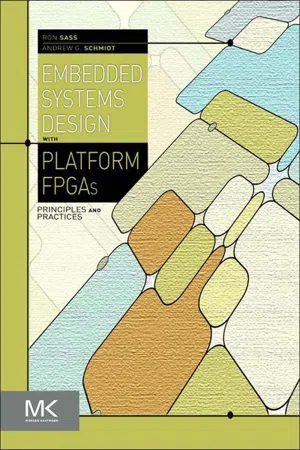
eBook - ePub
Embedded Systems Design with Platform FPGAs
Principles and Practices
- 408 pages
- English
- ePUB (mobile friendly)
- Available on iOS & Android
eBook - ePub
About this book
Embedded Systems Design with Platform FPGAs introduces professional engineers and students alike to system development using Platform FPGAs. The focus is on embedded systems but it also serves as a general guide to building custom computing systems.
The text describes the fundamental technology in terms of hardware, software, and a set of principles to guide the development of Platform FPGA systems. The goal is to show how to systematically and creatively apply these principles to the construction of application-specific embedded system architectures. There is a strong focus on using free and open source software to increase productivity. Each chapter is organized into two parts. The white pages describe concepts, principles, and general knowledge. The gray pages provide a technical rendition of the main issues of the chapter and show the concepts applied in practice. This includes step-by-step details for a specific development board and tool chain so that the reader can carry out the same steps on their own.
Rather than try to demonstrate the concepts on a broad set of tools and boards, the text uses a single set of tools (Xilinx Platform Studio, Linux, and GNU) throughout and uses a single developer board (Xilinx ML-510) for the examples.
- Explains how to use the Platform FPGA to meet complex design requirements and improve product performance
- Presents both fundamental concepts together with pragmatic, step-by-step instructions for building a system on a Platform FPGA
- Includes detailed case studies, extended real-world examples, and lab exercises
Frequently asked questions
Yes, you can cancel anytime from the Subscription tab in your account settings on the Perlego website. Your subscription will stay active until the end of your current billing period. Learn how to cancel your subscription.
At the moment all of our mobile-responsive ePub books are available to download via the app. Most of our PDFs are also available to download and we're working on making the final remaining ones downloadable now. Learn more here.
Perlego offers two plans: Essential and Complete
- Essential is ideal for learners and professionals who enjoy exploring a wide range of subjects. Access the Essential Library with 800,000+ trusted titles and best-sellers across business, personal growth, and the humanities. Includes unlimited reading time and Standard Read Aloud voice.
- Complete: Perfect for advanced learners and researchers needing full, unrestricted access. Unlock 1.4M+ books across hundreds of subjects, including academic and specialized titles. The Complete Plan also includes advanced features like Premium Read Aloud and Research Assistant.
We are an online textbook subscription service, where you can get access to an entire online library for less than the price of a single book per month. With over 1 million books across 1000+ topics, we’ve got you covered! Learn more here.
Look out for the read-aloud symbol on your next book to see if you can listen to it. The read-aloud tool reads text aloud for you, highlighting the text as it is being read. You can pause it, speed it up and slow it down. Learn more here.
Yes! You can use the Perlego app on both iOS or Android devices to read anytime, anywhere — even offline. Perfect for commutes or when you’re on the go.
Please note we cannot support devices running on iOS 13 and Android 7 or earlier. Learn more about using the app.
Please note we cannot support devices running on iOS 13 and Android 7 or earlier. Learn more about using the app.
Yes, you can access Embedded Systems Design with Platform FPGAs by Ronald Sass,Andrew G. Schmidt in PDF and/or ePUB format, as well as other popular books in Computer Science & Hardware. We have over one million books available in our catalogue for you to explore.
Information
Table of contents
- Cover image
- Title page
- Table of Contents
- Copyright
- Preface
- Acknowledgments
- 1. Introduction
- 2. The Target
- 3. System Design
- 4. Partitioning
- 5. Spatial Design
- 6. Managing Bandwidth
- 7. Outside World
- Glossary
- Index